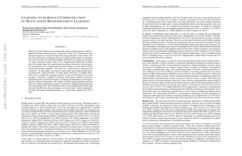Cross-modal Learning by Hallucinating Missing Modalities in RGB-D Vision
Diverse input data modalities can provide complementary cues for several tasks, usually leading to more robust algorithms and better performance. However, while a (training) dataset could be accurately designed to include a variety of sensory inputs, it is often the case that not all modalities are available in real life (testing) scenarios, when the model is to be deployed. This raises the challenge of how to learn robust representations leveraging multimodal data in the training stage, while considering limitations at test time, such as noisy or missing modalities. This chapter presents a new approach for multimodal video action recognition, developed within the unified frameworks of distillation and privileged information, named generalized distillation. We consider the particular case of learning representations from depth and RGB videos, while relying on RGB data only at test time. Our approach consists in training a hallucination network that learns to distill depth features through multiplicative connections of spatiotemporal representations, leveraging soft labels and hard labels, and the euclidean distance between feature maps. We report state-of-the-art or comparable results on video action recognition on the largest multimodal dataset available for this task, the NTU RGB+D, as well as on the UWA3DII and Northwestern-UCLA.
PDF Abstract



